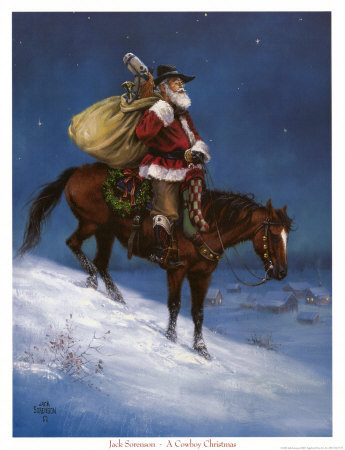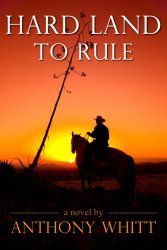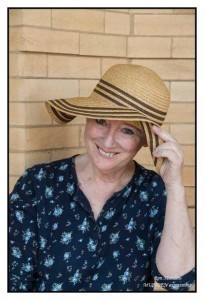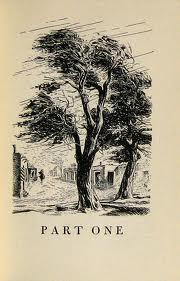Julia Robb's Blog, page 6
April 10, 2015
The Perils of Being a Mail Order Bride–or the Customer
MAIL ORDER BRIDE! I understand why men living in the Old West would order a bride, but why would any woman want to be a mail order bride?
Chris Enss, were these women unattractive or elderly?
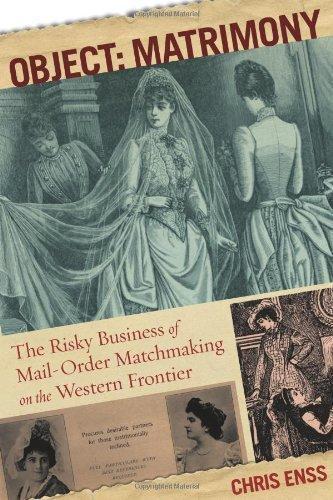 (Readers, Chris Enss is an American author and screenwriter. She has written more than 20 books on the subject of women in the Old West, and has collaborated with producer Howard Kazanjian on four books, including two about Roy Rogers and Dale Evans).
(Readers, Chris Enss is an American author and screenwriter. She has written more than 20 books on the subject of women in the Old West, and has collaborated with producer Howard Kazanjian on four books, including two about Roy Rogers and Dale Evans).
Answer – When gold was discovered by James Marshall in 1848, it let loose a flood of humanity onto the frontier. The number of marriageable men in the east was substantially lessened and the numbers were even further decreased by the time the Civil War ended.
In late 1865, women were looking for husbands and the bulk of the men to select from were based in the west.
Men and women primarily advertised for a spouses in a newspaper called “Matrimonial News.” There were old maids and some not-so-pretty ladies who seized the opportunity to find a husband by placing an ad.
Likewise, there were male spinsters and homely gentlemen who wanted a wife and employed such methods to find someone who wanted to marry them. The time was right and there was a unique opportunity for everyone who was lonely to find someone to spend their lives.
Q. Did couples write back and forth before the man ordered a bride?

Unidentified mail-order bride, from “Matrimonial News,” in 1891. Courtesy of Searls Historical Library.
A. Men and women did correspond, but the mail service was quite different then. If couples exchanged more than four letters before a proposal of marriage was made that was considered by most as a long courtship. It took months for letters to get from point A to point B.
Q. Today, men and women searching for a partner on dating sites often misrepresent themselves, even to their looks and age. Did the same thing happen with mail order brides and their grooms? Then what!!?
A. There were many people who misled potential spouses via the mail. There were laws against women misrepresenting themselves in mail order ads. Law enforcement agents would frequently circulate flyers warning men against falling for women who had false breasts and bolstered 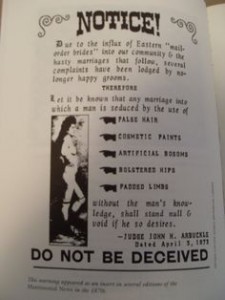 hips.
hips.
Men were under no obligation to honor their proposal if they discovered the woman they advertised for was any less than what they claimed to be.
Women would often ask for a certain sum of money to be settled on them before they left their homes in the east to come west. They were allowed to keep that sum of money if they discovered the men who answered their ads were nothing like they wrote in their letters.
Q. What’s the best and worst stories about mail order brides?
A. Mail order bride Eleanor Berry represents both the best and worst of the venture. She traveled from Gilroy, California to marry the man of her dreams living in Nevada County, California.
While en route the stage she was traveling on was held up by four masked bandits. The bandits demanded the passengers in the stage surrender their personal possessions. The thieves ransacked the passengers trunks as well and took whatever they wanted. 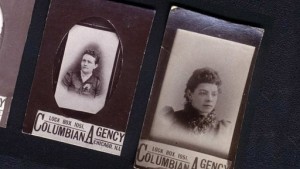
Eleanor pleaded with the men to let her go with her things. She explained she was on her way to get married and needed her belongings to start a new life. One of the masked bandits gave her permission to go along unmolested.
She was relieved, but still shaken by the time she reached her future sister-in-laws home. Eleanor quickly changed into her wedding garb and was ready to walk down the aisle at the appropriate time in the wedding ceremony.
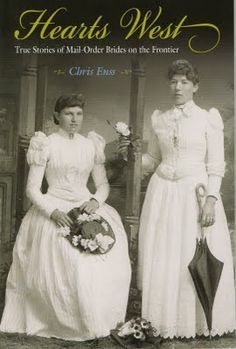 There she met her betrothed for the first time.
There she met her betrothed for the first time.
As the two were exchanging vows she realized that her voice sounded familiar. After a brief moment it occurred to her that this was the same man bandit who robbed the stage.
Eleanor ran out of the house and left the area. She returned to Gilroy where she tried to commit suicide. The humiliation of the event was more than she could bear.
Q. You seem to have had a wide-ranging career. Can you tell us something about that?
A. I always wanted to write. I initially wanted to write comedy, but fortunately I got a break writing westerns and I am grateful. I’ve been blessed to have met a number of exceptional authors who write westerns and can’t imagine ever wanting to do anything other than what I’m currently doing.
I’m a member of Western Writers of America and the organization is dedicated to keeping western literature alive. It’s a great organization and the members are some of the finest people I’ve ever met.

by Michael Goettee
Q. What are the two most fascinating facts you’ve discovered in your research, and or the two most fascinating characters?
A. How about one of each? Kate Rockwell is one of the most fascinating characters I’ve had the privilege to write about. She was a talented entertainer in the Northwest in the mid-1870s. She was known as the Queen of the Yukon, the toast of the sourdoughs. She sang and danced and made a fortune in the trade.
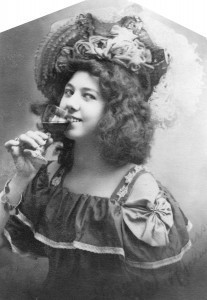
Kate Rockwell
She married poorly, however. Her two-timing husband took her money and invested in Nickelodeons. He left Kate a pauper and married a younger woman. Kate died with nothing and her no-good spouse became well-known as a theatre manager.
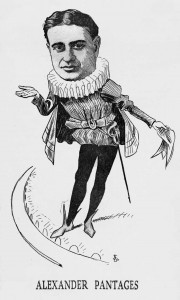 His name was Alexander Pantages. The Pantages Theatres are still in business. Kate Rockwell made that possible.
His name was Alexander Pantages. The Pantages Theatres are still in business. Kate Rockwell made that possible.
Now for the fascinating fact – pioneers trekking across the plains believed that you could preserve the life of your teeth and improve your breath if you gargled with your own urine.
I wrote a book entitled “The Doctor Wore Petticoats: Women Physicians of the Old West” and researched hundreds of “wagon train remedies” the settlers subscribed. 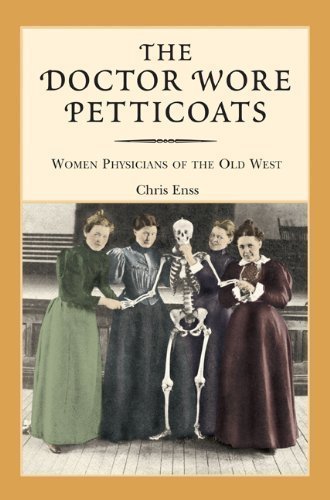
Q. Is your brother really in federal prison?
A. My brother is in federal prison. He has been there for more than eleven years. He has Parkinson’s disease and it’s been hell. I would do anything to save him.
To watch him die slowly has been a nightmare. “The Plea,” a journal I’ve been keeping since my brother has been incarcerated is the tale of this horrifying journey. I wish it wasn’t true, but it is. 
My brother can hardly hold his head up now, the disease has so taken over. He was beaten and raped and that exasperated the disease. He’ll die in prison, but not before he goes completely blind and is unable to walk.
Q. You’re a comedian? What inspired that? 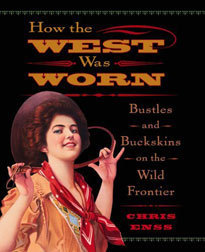
A. I liked to make people laugh and can usually find the funny in most everything. Like a lot of comics, the inspiration for wanted to make people laugh came out of great sorrow I experienced as a kid. I made fun of the circumstances as a way to deal with it.
Q. Do you still work in comedy?
A. I work a lot of humor in with the presentations I do about women of the Old West. I enjoy entertaining and making history fun to learn. I haven’t performed in a comedy club for awhile. That’s such a hard life and I just didn’t have what it takes to continue on with it.
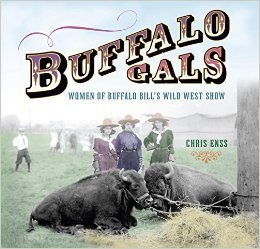 Q. When and why did you become a writer?
Q. When and why did you become a writer?
A. I began writing professionally in college. I penned a short story about my brother Scott. He was sick and I wanted to put in writing what it was like to watch him struggle. The story received high praise from my teacher who encouraged me to continue writing.
I’ve written for newspapers, television news, comics, commercials, and magazines. It has led me to writing westerns. I’m grateful.
Long live the west.

Chris Enss
The post The Perils of Being a Mail Order Bride–or the Customer appeared first on .
March 20, 2015
Indians, Cavalry, Custer and Sand Creek
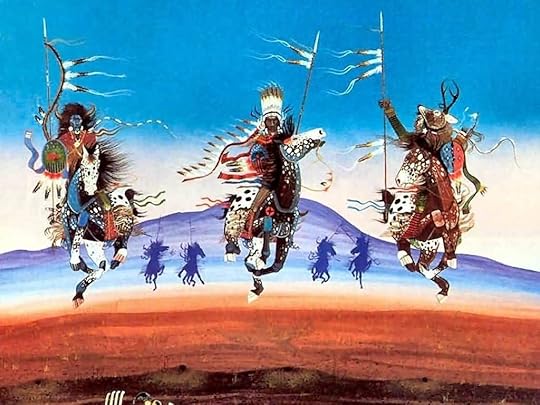
Hello Readers: Tribal peoples and Whites have a vexed history, one I’ve been asking writers, historians and (one artist) to comment on for the last year.
Here are some of the more thought-provoking statements and/or historical facts.
About Sand Creek, Gregory Michno had much to say.
Michno has written numerous books on the West, including, The Battle of Sand Creek: A Military Perspective.
(Sand Creek occurred in 1864 when a 600–to–700 man force of Third Colorado (U.S. Volunteer) Cavalry attacked and destroyed a Cheyenne and Arapaho village in southeastern Colorado Territory, killing between 70–163 Indians, many of whom were women and children).
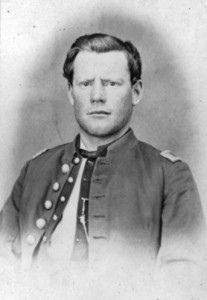
Capt. Silas Soule, who refused to attack the people at Sand Creek, actually tried to stop the raid in advance.
At the time, the Cheyenne were discussing peace with the whites.
Michno said, “The Cheyenne and Arapaho were raiding and killing all summer and into the fall of 1864.
“Now, as to who was to blame for ‘starting’ it all is endlessly debatable, independent of the facts, and resolvable only through the preconceptions of the individual.
“These Indians held seven white captives, which they admitted they had in their letter asking for peace.
“Soldiers tried to procure all of them, but were only given four, possibly a hedging by the Indians who figured it was not a good idea to give up all their bargaining chips.
“It seems accurate to assume, however, that the Cheyenne and Arapaho, after the Camp Weld Conference in September 1864, and with the assurances they were given by Major Edward Wynkoop, believed that they were reasonably safe.

This might be Chief Lean Bear, who was killed at Sand Creek.
“Perception, however, is individually and group oriented. The village attacked on Sand Creek contained warriors who had been killing and raiding.
“Some will argue that they now had immunity, others will disagree.
“Again it depends on individual biases and no amount of ‘facts’ or reasoning will make any difference.
“The village also contained women and children who had been doing nothing warlike except supporting their men. Were they legitimate targets? Were white homesteaders legitimate targets for Indian warriors?
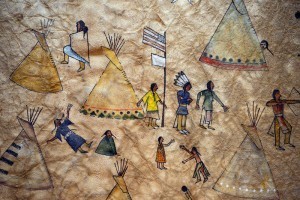
Sand Creek
“If I had my choice, I’d say leave the women and children out of it, but war has a way of ignoring personal preference.
“One point that few people realize is that there were 76 white casualties at Sand Creek.
“It doesn’t sound like much, but it represents the sixth largest white casualty count in all the 1,450 fights between 1850 and 1890.
“Some people will undercount the white casualties, just as others will overcount the Indian casualties.
 “A major factor involved is our ‘gut’ reaction to the atrocities. Seventy-six soldier casualties is just a statistic.
“A major factor involved is our ‘gut’ reaction to the atrocities. Seventy-six soldier casualties is just a statistic. “One pregnant Indian woman scalped and mutilated is the story we remember. That is human nature doing the talking.”
Question: Did the soldiers deliberately murder women and children?
Michno: “Certainly there were soldiers who deliberately killed women and children. There were also soldiers who saved women and children.
“The eyewitness testimony has enough examples to prove that there were scalpings and mutilations. The record also has examples of soldiers who were appalled by the action and expressed their revulsion of it.”
From Anthony Whitt, author of Hard Land To Rule and Cold Hard
 Ride, talking about the gun which conquered the Comanches: “The first effective use of repeating firearms against the Comanche happened in 1844, in Kendall County at the Guadalupe River crossing south of Sisterdale.
Ride, talking about the gun which conquered the Comanches: “The first effective use of repeating firearms against the Comanche happened in 1844, in Kendall County at the Guadalupe River crossing south of Sisterdale.“Called the Battle of Walker Creek or the Battle of Sisters Creek, it found Texas Rangers under the command of Jack Hays repulsing overwhelming numbers of Comanche at close range.
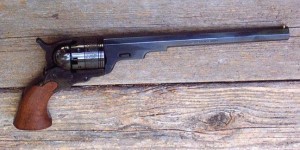
The revolver which won the Comanche Wars for Texas
“The Indians expected the normal shoot and reload pause they had become accustomed to.
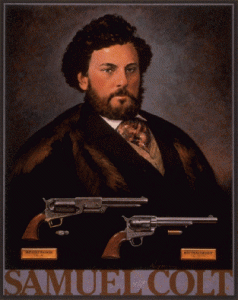 (But) “The Rangers took them by surprise with the repeating capabilities of the five-shot revolving pistol manufactured by Sam Colt’s Patent Arms Manufacturing Company.
(But) “The Rangers took them by surprise with the repeating capabilities of the five-shot revolving pistol manufactured by Sam Colt’s Patent Arms Manufacturing Company. “The ‘Navy Colt’ forever altered the balance of power in favor of well equipped Rangers. They quickly earned the reputation as ‘One of the most brutally efficient tracking and killing machines ever fielded.'”
For those of you who haven’t read Sam Gwynne’s Empire of the Summer Moon, Comanche War Chief Quanah Parker was the son of white captive Cynthia Ann Parker and Comanche Peta Nocona.
After Quanah’s surrender, he began a successful businessman in the white world and eventually world-famous.
Sam Gwynne: “Quanah
 Parker was a great man, and proof that there are second acts in American lives.
Parker was a great man, and proof that there are second acts in American lives.“That one of the greatest plains warriors later started a school district and testified brilliantly for Indian rights in Washington is one of the most amazing things I have ever heard.”
Fred Wagner, author of two books on Custer’s Last Stand, said he is “a critical defender of George Custer.”
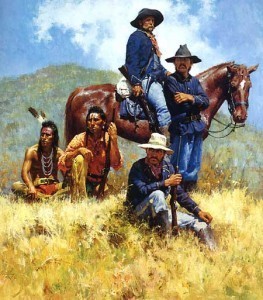
Before the Little Big Horn by Howard Terpning
Those books are The Strategy of Defeat at the Little Big Horn and Participants in the Battle of the Little Big Horn.
“His orders aside, Custer performed as many military men would have… with some exceptions.
“Unfortunately, those exceptions got him killed, but they were exceptions within the man’s make-up, within the man’s history, and within the man’s experience.
“Custer was an aggressive commander, but on this day he took too many risks and committed the classic blunders of an over-confident commander: refusal to heed the signs his scouts warned him about; underestimating the size and intentions of his enemy; not keeping his subordinate commanders informed; and allowing his divided command to fall away from mutual support.
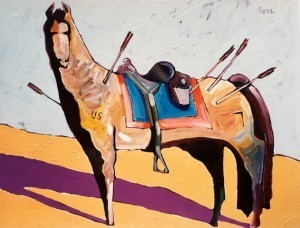
Comanche, by Thom Ross.
“Too many people blame both this division of command and his tactics for the regiment’s defeat, but neither, specifically, is the case.
“As he subverted the strategic plans, so he subverted his tactical plans by allowing these subordinates to fall away with no support.”
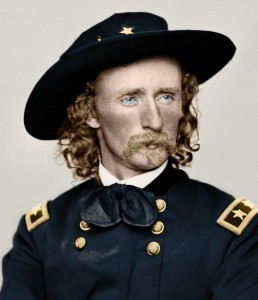 When asked about his view of Custer, Jeff Barnes, author of The Great Plains Guide to Custer, said “Unfortunately, many folks draw their history from popular culture or the biased opinions of others.
When asked about his view of Custer, Jeff Barnes, author of The Great Plains Guide to Custer, said “Unfortunately, many folks draw their history from popular culture or the biased opinions of others. “My own cousin – when I told her I was writing a book about him – said ‘I hate Custer,’ and I know she hadn’t cracked a history book in more than forty years!
“He certainly wasn’t a psychopath – the Army didn’t keep those commanders in the field.
“I wouldn’t call Custer disastrous, either – he had had success on the plains and Sheridan and Sherman fervently wanted him on the 1876 campaign. He came into a disastrous situation, but it wasn’t one of his making.
“I don’t know if ANY Army commander active at the time could have found success at Little Bighorn, but I do think Custer had the best chance of it.”

Scott Zesch, author of The Captured, had a fascinating take on white captive children.
Question: Once they were returned to their families, captive children couldn’t stay married, they couldn’t keep a job, some of them never learned to read and write, they couldn’t stay in one place, they had a hard time communicating and generally seemed like unhappy people.
Can you explain why being a captive had this effect on the children?
Zesch: “I think the children responded very positively to the freedom
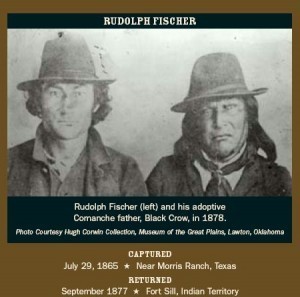 of the Comanche way of life.
of the Comanche way of life.“Most of them had known nothing but hard work on frontier farms before they were captured, and they discovered for the first time that there was another way to live.
“Once they got back home, I think they felt terribly confined.
“By then, their Comanche friends had been sent to the reservation, so there was no way the former captives could go back to the roving life they had known with them.”

Dot Babb
Q. The children did not seem angry at the Comanches, although the Comanches killed some of the children’s families, and committed atrocities in front of them. Can you explain why?
Zesch: “They didn’t seem to transfer their hatred of the individuals who killed their relatives to the Comanche people as a whole.
“Former captive Dot Babb put it best: “You wouldn’t want to kill every white person you saw because some white person had killed your mother.”
Finally, here’s what artist Thom Ross had to say about the meaning of Custer’s
 Last Stand: “With no basis in the historical record on HOW he died (other than the bullet that smacked him in the left breast) it is remarkable that when we re-create Custer in art, he is standing (usually at dead-center) and battling away while the warriors swarm all around him.
Last Stand: “With no basis in the historical record on HOW he died (other than the bullet that smacked him in the left breast) it is remarkable that when we re-create Custer in art, he is standing (usually at dead-center) and battling away while the warriors swarm all around him.“He is, indeed, resisting the inevitable death that awaits not only him but ALL of us….and knowing this, he battles on, heroically wielding a saber he didn’t have, his long hair flowing out behind him (which he also didn’t have.)

by Thom Ross
“So Custer represents something MORE than himself. You see this same thing when you watch ROCKY….the bum-boxer who, Custer-like, gets in WAY over his head yet will not concede defeat and, in the end, when he IS defeated, he is the hero.
“Same story being told over and over for thousands of years….and in defeat, Rocky does not call out for redemption nor for vengeance, he calls out for love…”ADRIAN!”
“It’s wonderful.
“Again, whether he meant to or not, Sly Stallone (who wrote Rocky) touched that area, that part of us, that responds to this heroic myth.
“Thru defeat comes victory.”

by Thom Ross
The post Indians, Cavalry, Custer and Sand Creek appeared first on .
February 22, 2015
Big Wayne Dundee Hits Amazon Pay Dirt With Westerns
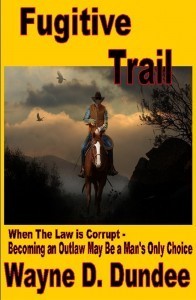 Big Wayne Dundee took control of his longtime writing career last Fall, began to make money and has never looked back.
Big Wayne Dundee took control of his longtime writing career last Fall, began to make money and has never looked back.Dundee (whose friends really call him “Big Wayne”) lives in what was once a notorious cowtown, Ogallala, Nebraska. He’s a widower who began writing more than 30 years ago but went full-time after he retired from a managerial position in the magnetics industry.
Most of Dundee’s early work featured his PI protagonist Joe Hannibal. Titles in the Hannibal series have been translated into several languages and he’s also the founder and original editor of Hardboiled Magazine.

But Dundee now writes Westerns and has a growing following. Western Fictioneers has given him three Peacemaker Awards, including “best first Western novel” for DISMAL RIVER .
Wayne, thanks for the interview.
Q. You are a very productive writer! How many books have you written?
A. So far I’ve written about 27 novels and over three dozen short stories. My earliest books (nine in the Joe Hannibal PI series) ran 80–100,000 words; my later work, mostly in the Western genre, qualify more as short novels or novellas and tend to run more in the 30–50,000 word range.
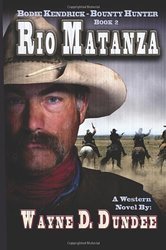 Q. About a month ago, you had six books on Amazon’s Top 100, most of them in the top 50. How did you do that?
Q. About a month ago, you had six books on Amazon’s Top 100, most of them in the top 50. How did you do that?A. I’m really not sure. If I knew for certain, I guarantee I would have done it a heck of a lot sooner.
What I can tell you is this: For starters, eBooks, POD, and self-publishing played a big part for me. I think it also helps to have a good backlog of titles and for at least some of them to be part of a series …
In my specific case, with these tools at hand and having received some lessons on Kindle preparation and cover creation, I reached a point where I decided I would quit being dissatisfied with the way others were handling my work and take a shot at doing it the way I thought it should be done.

With my sales hardly setting the world on fire the way it was, what did I have to lose?
So, early last fall, I reclaimed publishing rights to as many titles as I could get my hands on, re-formatted them, created new covers, and started re-releasing them through Kindle Direct for 99-cents each.
One title in particular — a brand new, just-completed Western entitled FUGITIVE TRAIL — took off right away. And then the others, slowly but surely, started following along in what I came to call “the slipstream effect.”
 Titles still available through other publishers (apart from my own Bil-Em-Ri media, cleverly named after my grandkids) seemed to get caught up in this, too …
Titles still available through other publishers (apart from my own Bil-Em-Ri media, cleverly named after my grandkids) seemed to get caught up in this, too …I hesitate to mention this for fear of jinxing it but, pretty much from November on, I’ve regularly had anywhere from six to ten titles in Amazon’s Top 100 for Books>Genre Fiction>Westerns.
So in conclusion, I can only chalk it up to a good array of titles, attractive pricing and covers, and the ever-elusive intangibles of timing and luck … As I write this, sales seem to be leveling off a bit so I don’t know how long it will last; but I will certainly welcome and enjoy it while it does.
Q. You began your writing career with detective/thriller novels. Why did you switch to Westerns?
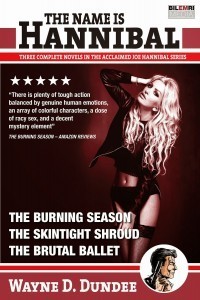
A. Number One: Because interest in male protagonist PI mysteries seemed to dry up, at least for my Joe Hannibal series. I always got good reviews, but my sales were never worth beans.
Number Two: After moving to west central Nebraska in 1998, to an area so rich with “Wild West” history, the interest/inspiration to try my hand at Westerns — a genre I’d always enjoyed and often thought about trying — kicked in pretty strong.
Number Three: I found that, after I had a couple under my belt, my enjoyment of writing Westerns, combined with the nice reception my work in the genre received, pretty much sealed the deal on doing more … Although I haven’t abandoned the PI mystery completely; Joe Hannibal’s pulse still beats and readers will be seeing more of him from time to time.
 Q. Do you write Westerns in the tradition of Louis L’Amour, Max Brand and Luke Short?
Q. Do you write Westerns in the tradition of Louis L’Amour, Max Brand and Luke Short?A. In the sense that these gentlemen are all authors of “traditional” Westerns, I guess that, yeah, I do. Though none of these three are among my favorites or whose work I would say had any influence on me.
Gordon D. Shireffs, T.V. Olsen, Elmer Kelton, John Benteen, Robert MacLeod … those were my guys.
Q. Many social pundits have declared Westerns a dead genre, but it seems many readers still love Westerns. What do you think about this?
A. Westerns are distinctly, uniquely American yet have developed a worldwide appeal. For these reasons I don’t think the genre will ever completely “die.” Their appeal will ebb and flow and may very well have peaked, especially cinematically … but die? Nope, I don’t see it.
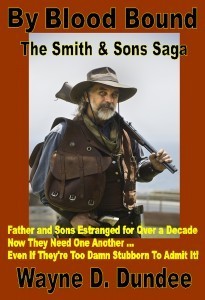
In fact, I think eBooks have currently revived it as far as having an audience of readers.
Q. Why do you enjoy the Western experience? What is it about that particular time and history?
 One of the reasons I enjoy working in the Western genre is that it’s a chance to play cowboy all over again, just like when I was a kid. I suspect guys of my generation never grow out of that completely. (Of course, as my late wife often reminded me, [and as I suspect is also true of other guys] there are many examples of me never growing up completely.)
One of the reasons I enjoy working in the Western genre is that it’s a chance to play cowboy all over again, just like when I was a kid. I suspect guys of my generation never grow out of that completely. (Of course, as my late wife often reminded me, [and as I suspect is also true of other guys] there are many examples of me never growing up completely.) On a more serious note, I also feel that the bursting, boisterous Old West gave us examples of American spirit, individuality, and grit at its finest.
On a more serious note, I also feel that the bursting, boisterous Old West gave us examples of American spirit, individuality, and grit at its finest. Yes, there was corruption, cruelty, and abuse (toward women and Native Americans, as examples) too.
Unfortunately, those kinds of things have been part of any time or place you can name in history.
But never forget that, in the Old West, there also a special kind of bravery and wild nobility. That’s the part that stirs me.
Q. Who are your favorite writers, and why?
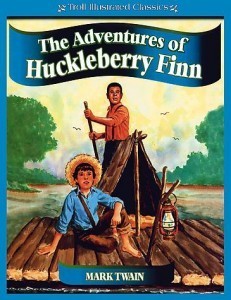
I am woefully under-exposed to so-called classic literature or work that most people would consider that of any great substance. I consider myself a modern day pulp writer and my ultimate goal was always aimed toward same.
Therefore, with the exception of Mark Twain — whose HUCKLEBERRY FINN , in my humble opinion, ranks as one of if not the most important novels of all time — my favorite writers are of the pulp (and I use the term with great fondness and respect) variety.
Prominent among them: Edgar Rice Burroughs, Robert E. Howard, Mickey Spillane, John D. MacDonald, and Donald Hamilton; plus the Western genre writers mentioned above …
Why? Because they are skilled craftsmen who tell tales that are entertaining as hell. That pretty much says it all.
http://fromdundeesdesk.blogspot.com
The post Big Wayne Dundee Hits Amazon Pay Dirt With Westerns appeared first on .
February 20, 2015
Big Wayne Dundee Hits Amazon Pay Dirt With Westerns
 Big Wayne Dundee took control of his longtime writing career last Fall, began to make money and has never looked back.
Big Wayne Dundee took control of his longtime writing career last Fall, began to make money and has never looked back.Dundee (whose friends really call him “Big Wayne”) lives in what was once a notorious cowtown, Ogallala, Nebraska. He’s a widower who began writing more than 30 years ago but went full-time after he retired from a managerial position in the magnetics industry.
Most of Dundee’s early work featured his PI protagonist Joe Hannibal. Titles in the Hannibal series have been translated into several languages and he’s also the founder and original editor of Hardboiled Magazine.

But Dundee now writes Westerns and has a growing following. Western Fictioneers has given him three Peacemaker Awards, including “best first Western novel” for DISMAL RIVER .
Wayne, thanks for the interview.
Q. You are a very productive writer! How many books have you written?
A. So far I’ve written about 27 novels and over three dozen short stories. My earliest books (nine in the Joe Hannibal PI series) ran 80–100,000 words; my later work, mostly in the Western genre, qualify more as short novels or novellas and tend to run more in the 30–50,000 word range.
 Q. About a month ago, you had six books on Amazon’s Top 100, most of them in the top 50. How did you do that?
Q. About a month ago, you had six books on Amazon’s Top 100, most of them in the top 50. How did you do that?A. I’m really not sure. If I knew for certain, I guarantee I would have done it a heck of a lot sooner.
What I can tell you is this: For starters, eBooks, POD, and self-publishing played a big part for me. I think it also helps to have a good backlog of titles and for at least some of them to be part of a series …
In my specific case, with these tools at hand and having received some lessons on Kindle preparation and cover creation, I reached a point where I decided I would quit being dissatisfied with the way others were handling my work and take a shot at doing it the way I thought it should be done.

With my sales hardly setting the world on fire the way it was, what did I have to lose?
So, early last fall, I reclaimed publishing rights to as many titles as I could get my hands on, re-formatted them, created new covers, and started re-releasing them through Kindle Direct for 99-cents each.
One title in particular — a brand new, just-completed Western entitled FUGITIVE TRAIL — took off right away. And then the others, slowly but surely, started following along in what I came to call “the slipstream effect.”
 Titles still available through other publishers (apart from my own Bil-Em-Ri media, cleverly named after my grandkids) seemed to get caught up in this, too …
Titles still available through other publishers (apart from my own Bil-Em-Ri media, cleverly named after my grandkids) seemed to get caught up in this, too …I hesitate to mention this for fear of jinxing it but, pretty much from November on, I’ve regularly had anywhere from six to ten titles in Amazon’s Top 100 for Books>Genre Fiction>Westerns.
So in conclusion, I can only chalk it up to a good array of titles, attractive pricing and covers, and the ever-elusive intangibles of timing and luck … As I write this, sales seem to be leveling off a bit so I don’t know how long it will last; but I will certainly welcome and enjoy it while it does.
Q. You began your writing career with detective/thriller novels. Why did you switch to Westerns?

A. Number One: Because interest in male protagonist PI mysteries seemed to dry up, at least for my Joe Hannibal series. I always got good reviews, but my sales were never worth beans.
Number Two: After moving to west central Nebraska in 1998, to an area so rich with “Wild West” history, the interest/inspiration to try my hand at Westerns — a genre I’d always enjoyed and often thought about trying — kicked in pretty strong.
Number Three: I found that, after I had a couple under my belt, my enjoyment of writing Westerns, combined with the nice reception my work in the genre received, pretty much sealed the deal on doing more … Although I haven’t abandoned the PI mystery completely; Joe Hannibal’s pulse still beats and readers will be seeing more of him from time to time.
 Q. Do you write Westerns in the tradition of Louis L’Amour, Max Brand and Luke Short?
Q. Do you write Westerns in the tradition of Louis L’Amour, Max Brand and Luke Short?A. In the sense that these gentlemen are all authors of “traditional” Westerns, I guess that, yeah, I do. Though none of these three are among my favorites or whose work I would say had any influence on me.
Gordon D. Shireffs, T.V. Olsen, Elmer Kelton, John Benteen, Robert MacLeod … those were my guys.
Q. Many social pundits have declared Westerns a dead genre, but it seems many readers still love Westerns. What do you think about this?
A. Westerns are distinctly, uniquely American yet have developed a worldwide appeal. For these reasons I don’t think the genre will ever completely “die.” Their appeal will ebb and flow and may very well have peaked, especially cinematically … but die? Nope, I don’t see it.

In fact, I think eBooks have currently revived it as far as having an audience of readers.
Q. Why do you enjoy the Western experience? What is it about that particular time and history?
 One of the reasons I enjoy working in the Western genre is that it’s a chance to play cowboy all over again, just like when I was a kid. I suspect guys of my generation never grow out of that completely. (Of course, as my late wife often reminded me, [and as I suspect is also true of other guys] there are many examples of me never growing up completely.)
One of the reasons I enjoy working in the Western genre is that it’s a chance to play cowboy all over again, just like when I was a kid. I suspect guys of my generation never grow out of that completely. (Of course, as my late wife often reminded me, [and as I suspect is also true of other guys] there are many examples of me never growing up completely.) On a more serious note, I also feel that the bursting, boisterous Old West gave us examples of American spirit, individuality, and grit at its finest.
On a more serious note, I also feel that the bursting, boisterous Old West gave us examples of American spirit, individuality, and grit at its finest. Yes, there was corruption, cruelty, and abuse (toward women and Native Americans, as examples) too.
Unfortunately, those kinds of things have been part of any time or place you can name in history.
But never forget that, in the Old West, there also a special kind of bravery and wild nobility. That’s the part that stirs me.
Q. Who are your favorite writers, and why?

I am woefully under-exposed to so-called classic literature or work that most people would consider that of any great substance. I consider myself a modern day pulp writer and my ultimate goal was always aimed toward same.
Therefore, with the exception of Mark Twain — whose HUCKLEBERRY FINN , in my humble opinion, ranks as one of if not the most important novels of all time — my favorite writers are of the pulp (and I use the term with great fondness and respect) variety.
Prominent among them: Edgar Rice Burroughs, Robert E. Howard, Mickey Spillane, John D. MacDonald, and Donald Hamilton; plus the Western genre writers mentioned above …
Why? Because they are skilled craftsmen who tell tales that are entertaining as hell. That pretty much says it all.
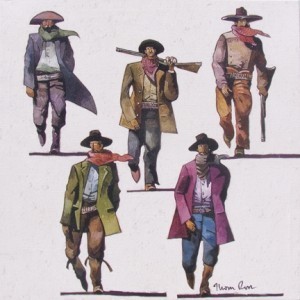
Painting by Thom Ross
http://fromdundeesdesk.blogspot.com
The post Big Wayne Dundee Hits Amazon Pay Dirt With Westerns appeared first on .
January 24, 2015
Thom Ross Reimagines Custer, Wyatt Earp and the Old West
Not just because his colors are stirring and the figures are drama in action (like the painting above, depicting The Gunfight at the OK Corral). You can see them move!
I was excited because ideas propel Thom’s art.
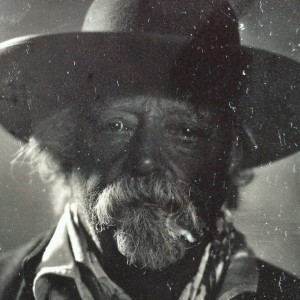
Thom Ross
What you see means something.
He is interpreting Western legend, explaining its higher meanings and defending it.
And he’s the only artist who has ever created 200 full-sized figures depicting the Seventh Cavalry and the Sioux and Cheyenne fighting at the Little Big Horn–and in 2005 the figures were actually erected on the battleground.
Thom was born in 1952 and raised in Sausalito, California. He now lives in Santa Fe and owns an art gallery.
Thom explains his fascination with the West as “heavily influenced by all the westerns produced back then on TV and in the movies.”
“When I was young I thought all that stuff was happening RIGHT NOW…gunfights and massacres and hangings and I was missing out on it all!
“So I thought I was living in the EAST when, in fact, you can’t get farther WEST then where I was growing up!”
Q. Why did you volunteer to create the cutouts for the Little Big Horn battlefield?
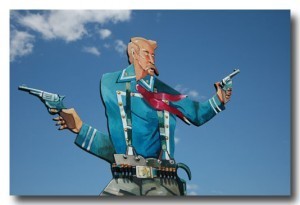
General Custer cutout
A. Custer’s Last Stand – The event itself has moved from historical fact into that realm of mythic legend, sure proof that it IS more than it was.
I had that youthful arrogance when I drove to the battlefield for the 100th anniversary of the fight (June, 1976.) I KNEW the real truth and I KNEW what really happened (that kind of arrogance!)
Well, what happened to me (and the four friends I was with) was a cosmic experience not of this world.
It happened on the afternoon of the battle date (June 25, 1976) as we stood atop Last Stand Hill. It lasted 20 minutes and when it was over I knew that I had moved into a whole new realm of reality, and a reality NOT of this world.
I realized that although I was a college grad, the simple fact was that I knew absolutely NOTHING.
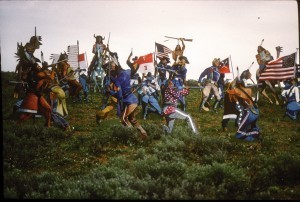
Last Stand cutouts
The profundity of this experience altered the entire way I now view both worlds that I live in.
My mind was blown and, in that manner, set free…free from convention and free from dogma etc. (hence my hatred of traditional western art: I’ve seen it ALL before and it does not teach me anything I don’t already know.)
So when I did my huge “Custer” installation it was to repay those men and women, both troopers and warriors who died that June day long ago so that I could be taught the lesson I needed to learn.

The Three Crow Scouts. Once Custer relieved them of duty “they rode over to a bluff above the Lakota/Cheyenne village and fired off a few rounds into the village. Cold-blooded and full of hate,” Ross said.
I owed it to them ALL..to the men who fought there that day and created that great and terrible tale.
Artists ever since paint and repaint to varying degrees of competence that silly fight for 100 years…..ok…..so I say, ‘Well, I want to do some Custer artwork but it has to be different in its venue….anyone can PAINT the damn thing…let’s raise the bar.’
So I do something that NO OTHER ARTIST has ever done or even attempted to do…..and who makes the western art money? The guys who take no chances and whose art work is as boring and blah as you can get.
Q. How did you create the figures?
A. “Custer” was the one that required more work; I had to draw out hundreds of figures on which I based the cut-outs.
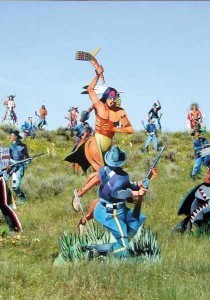
Custer Installation
Then, with my friend Guy, we spent two years cutting out Custer and 40 of his men along with 160 warriors (including two female warriors, as we know four women rode out to kick some Seventh cavalry BUTT that day!).
We had to sand and prep the surface of the cut-outs. I primed them and then had to paint them. Once the paint dried, I attached all sorts of buttons, pins, feathers, bells, fringe…just all sorts of shit on there and the wilder the better.
To recreate the Indian’s beadwork, I took small tubes of fabric paint and dabbed dot-by-dot-by-dot for THOUSANDS of dots to give the illusion of beadwork.
On nights when I worked late it would get dark.
I had placed upholstery tacks in the eyes of the horses and men to give those orbs a reflective quality. So I’d get set to leave the studio late at night and when I turned off the studio lights, the light from the city would flood the darkened studio and all these eyes would start to glow in the darkness! Fuckin’ freaked me OUT!

I mean all these warriors towering over me had come to life and their eyes were staring right at me! HAHAHAHA!!!
I had to back out of the studio all the while reminding them that I was their “father” and that I loved them and PLEASE don’t drive that hatchet into my skull.
A great sensation…..truly fearful….that’s when I knew I had something happening.
Q. How long were the cutouts on the battlefield?
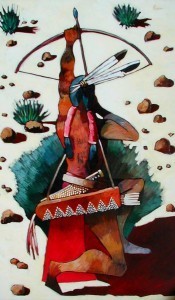
Indian Shooting Arrow
A. Four days on the battlefield. Seven days in Sun Valley, Idaho. Seven days in Jackson, Wyoming (where they remain stored in a shed, unviewed to this day.)
Q. Did you later sell them?
A. I sold a few…..not enough to pay even for the trip. People had no idea how to deal with them because they weren’t rectangular and sitting in frames.
BUT, when someone DID buy one and have them mounted on a wall in their home they are GREAT!
They have a presence that just a standard painting does not have.
Q. You defend Custer. What convinces you he was a good general, despite cultural disdain?
A. I don’t think he was a good commander….he was an excellent subordinate who could carry out orders. On my dream football team he would NOT be the quarterback…he’d be the half-back and we’d win a shit-load of games.
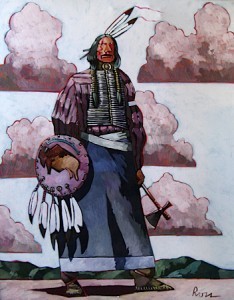
Indian With Shield and Hatchet
What I defend is both his historical role in the Civil War, which must be taken seriously if you want to know the WHOLE man.
My problem is that THROUGH Custer and his last stand I came to a whole different way of thinking about things OTHER than that silly fight. Custer was the catalyst for this revelation.
So when people toss him aside because THEY think they know so much and they are so god damn right and Custer is SUCH a jerk….they toss out so much more! They cheat themselves out of learning something deeper and more profound.
And it could be Custer or Crockett or Billy the fuckin’ Kid….It could be Jesus or God…..behind ALL these things lies a deeper truth and THAT is what we must learn.
You like Howard Terpning’s work and I don’t mean to pick on him alone….but he doesn’t paint that thing that is so true that you haven’t seen or felt it before….He gives you veneer of art without the meat and bones.
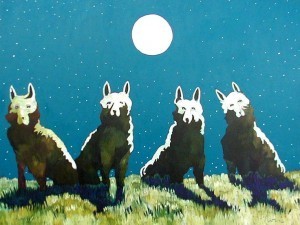
Smell of Death (at Beecher’s Island)
To find that sort of thing requires the person (artist or otherwise) to delve deeper into those ethereal things that they love….it doesn’t HAVE to be George Custer at all.
But when you take that plunge and submerge yourself beyond the surface where we all find comfort THEN you might find out that truth.
This is why when historians argue points about who did what where and why and argue facts and dates etc…..I dig that all…but I pay no attention to it because you are arguing the paint job on the car while I’m trying to find out how it runs.
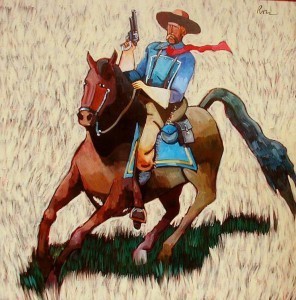
Red Tie
An artist’s job is to lead his audience to a place they never knew existed either in this world OR within themselves.
I’m at the Little Big Horn and this guy comes up to view the 200 figures. He is an attorney for Vietnam vets in Washington D.C. He asks if I’m the artist who did this thing.
I say “yes”….He leans into me and says, “I’ve seen three great things in my life. The Vietnam War Memorial in DC, the terra cotta soldiers in China….and what you have done here is the third!”
WHOA BABY!!!! I was in great company as far as that guy was concerned!
Q. Critics insist Custer was an Indian hater/killer. What do you think?
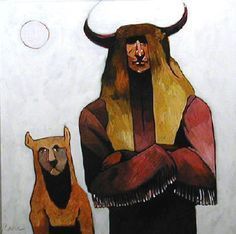
Buffalo Man and Dog
A. He was a product of his time, period. I was once asked during a lecture how I would have felt about blacks if I had been born in the South before the Civil War. I was stunned…I said, “I would have kept them as slaves and not worried a thing about that!”
They were startled…..so many of us THINK that we would have the clarity and honesty of contemporary thought which we have today! What a riot!
And THAT shows more to me about how people think then anything else…because they are not being truthful even unto themselves.
With no basis in the historical record on HOW he died (other than the bullet that smacked him in the left breast) it is remarkable that when we re-create Custer in art, he is standing (usually at dead-center) and battling away while the warriors swarm all around him.

Indian Scouting Party
He is, indeed, resisting the inevitable death that awaits not only him but ALL of us….and knowing this, he battles on, heroically wielding a saber he didn’t have, his long hair flowing out behind him (which he also didn’t have.)
So Custer represents something MORE than himself. You see this same thing when you watch ROCKY….the bum-boxer who, Custer-like, gets in WAY over his head yet will not concede defeat and, in the end, when he IS defeated, he is the hero.
Same story being told over and over for thousands of years….and in defeat, Rocky does not call out for redemption nor for vengeance, he calls out for love…”ADRIAN!”
It’s wonderful.
Again, whether he meant to or not, Sly Stallone (who wrote Rocky) touched that area, that part of us, that responds to this heroic myth. Thru defeat comes victory.
I had a gal come into my gallery once and she dissed Billy the Kid! YEAH! In my gallery she dissed the Kid….
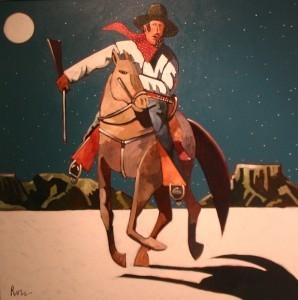
Moonlight Billy
I asked her to leave NOW.
I don’t believe in God in a religious or traditional sense; but I know enough now to NOT discount Him either.
And it is not so much about whether He exists or not that matters, but I know that if I toss Him out, I toss out a lot more than Him.
So I am a man of faith and I have the faith and if I came to that belief IN that faith via General Custer or Billy the Kid WHO CARES!
The important thing is ARRIVING at that point which we can call “the center” and KNOW that for who I am and what I am ..You need to understand BOTH sides, history AND myth….the yin-yan of life.
Q. Tell me about the Crazy Horse painting.
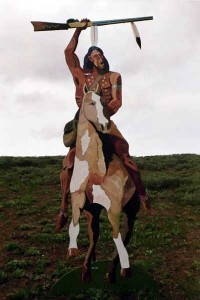
Crazy Horse
A. Crazy Horse – would love to have dinner with him just to listen to how he thinks. That mystic quality is so intriguing. But what we have done is to give that kind of mystic power to Indians and Indians ALONE.
I have seen this and I have even HEARD it. Mind-boggling…as if the fact is, that if you aren’t an Indian, well, you have nothing mystical about YOU.
You can see it in that crappy Indian art that white people do….the Indian ALWAYS looks so stern as he gazes off into the distance and we all fawn over that shit.
We, as humans, have that ability to go beyond ourselves and touch the void, I know: I’ve done it many times.
And the fact remains that the Indian was also a prankster, a joker, a story teller, a gambler, a baseball player, a wife-beater, a drunk, and at times a cold-blooded killer (those feathers in his war bonnet were not for tying knots or helping old ladies across the street.)
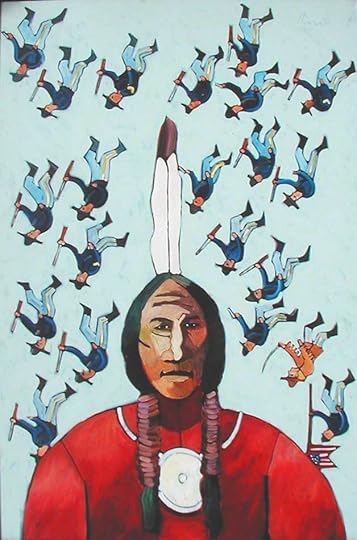
Sitting Bull’s Vision
He was a slave runner and, likewise, a slave long before the white guy got here.
He could never make a wheel although he saw them and the biggest boat he ever built was what, a canoe? We have endowed this guy with so much unreal crap that the REAL Indian has gotten lost (again, look at all that shitty artwork out there!)
The sad fact is that the Indian of today now believes the white man’s myth and has forgotten that he, too, is just another schmuck trying to get thru this life like the rest of us.
He hates me for things that never happened to him and that I never DID to them. Their clue? I’m white…..we call that racism.

Custer
So I would love to talk to Crazy Horse about that kind of stuff and I am sure he would be very disappointed in what has become of his once great people…..
Can you see Crazy Horse standing in front of a fucking casino going, “WTF is this?…who have we become? Embracing the very worst of the white man’s world!!!”
He’d never stop throwing up.
Q. You have painted so many OK Corral canvases. What interests you?
A. The story of the OK Corral seems to unfold in a Shakespearian manner rather then just as a singular burst of violence like the Custer fight. Maybe it’s the urban setting because I come from an urban area, not a rural one.
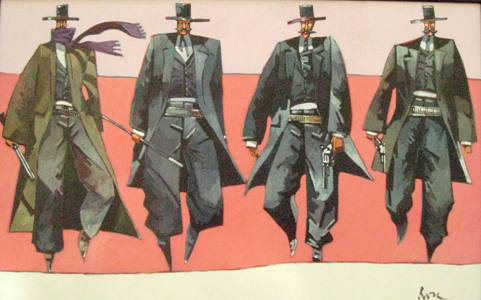
Down Fremont Street
Where the Custer fight can be seen as a clash of cultures, the OK Corral saga seems to reflect how we as AMERICANS are going to deal with law and outlaw….it seems a simpler thing maybe.
I was with Paul Hutton once and a fellow asked him, “When did the OK Corral gunfight begin?” and Paul answered, in all sincerity, “When the Pilgrims landed on Plymouth Rock.”
Q. What do you think of the writers and historians who attack Wyatt Earp and accuse him of everything from being a gamber (as if that was a bad thing), to living with a floozy, to a hundred other things?
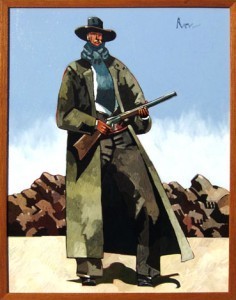
Doc Holiday
A. I think nothing of them because they are attacking a part of Earp which I am already beyond. Earp does not have to apologize to me or any of these other BUMS for being who and what he was.
Indeed, we created him and then for us to be shocked when that creation is wrong is a joke.
They do the same to Babe Ruth and even Jesus Christ…so Earp is at least in good company!
I dig Jim Bowie and a bigger swindler and con-man hardly ever existed. Yet with his martyrdom at the Alamo ALL his transgressions are forgiven!
Ain’t THAT Biblical?
So when I happen upon a book which sets out to attack one of my heroes I just close the book because I can tell that the author has already missed the point, the MEANING, of Wyatt Earp.
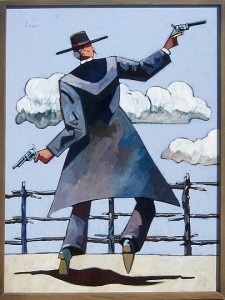
Wyatt Earp
If he consorted with whores and low-life’s that is ALL fine with me…it was HIS life and not mine.
I am honored that my father and Wyatt Earp lie near each other in their graves……good god damn company for both of them.
Q. You’ve painted some Civil war scenes. What interests you?
A. I love conflict…..war, gunfights, baseball….men in conflict. But what happens in the midst of such carnage as the Civil War is that out of the muck and blood and shit comes a man like Richard Kirkland, the “Angel of Fredericksburg,”who brought water from his Rebel lines to the wounded Union soldiers lying in front of the stone wall and gave them comfort and solace.

The Northern Lights of Frederickburg
I mean WOW……that act alone raised ALL humanity by his small example.
The Civil War (like most things) is full of such stories of man’s nobility rising out of the muck of battle.
Even the nerve shown by the Union men at Fredericksburg, or the Rebels during Pickett’s Charge, and the Massachusetts 54th black brigade charging Battery Wagner KNOWING that they were playing for a higher thing…..makes you believe in mankind again.
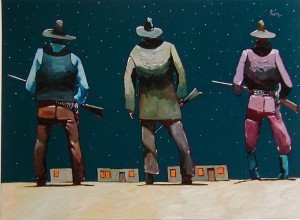
Arrival at Fort Sumner
It is not the issue of who is right or who is wrong…..it is an issue of commitment of your own self. Columbus crossing the Atlantic. Mallory disappearing on Everest. Neil Armstrong walking on the moon. WOW…what a remarkable thing we are.
Q. Croquet???? Why have you painted indians holding croquet mallets?

Modoc Croquet Player
A. I have either photographic OR eye-witness proof that Indians played ping-pong, croquet (Modocs – Quapaw Agency, OK. Nov. 1873), golf and baseball.
Same with outlaws playing croquet and cowboys playing golf (their golf bags hanging over their saddle horns!)
So if I can verify it, then I can paint it…I never make something up because I think it’s cute.
But I did a painting of Indians playing ping-pong and this dip-shit guy walks in off the street and verbally attacks ME for showing his “native Americans” in such a foolish scene.
He had no way of knowing that I had the photograph of them actually PLAYING ping-pong…..this is the kind of PC bullshit I have to deal with…..if it goes against the MYTH then we must destroy it, and the myth here is that Indians don’t have fun!
Stunning……but there is a very famous photo of Custer and Libbie having lunch in Kansas, 1867, and you can see the croquet mallets and balls right there by the tent.
Q. Are you selling art?
A. I was for 30 years! Making $150K a year!!! A GREAT life…..but it has evaporated in the last 6 years. I don’t know why.
It could be a cultural thing where art itself doesn’t matter…it’s been replaced by computers etc. so there is no need for art.
Maybe the “values” that my art embraces is anachronistic…..honest passions and heroic impulses have no place in today’s world of juiced up athletes and lying politicians.
The men of the Alamo, could they see who we’ve become, would reconsider their valiant stand.
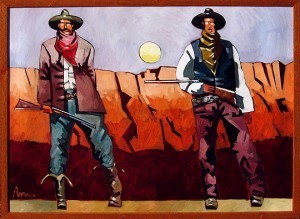
Mooonrise Over Red Wall
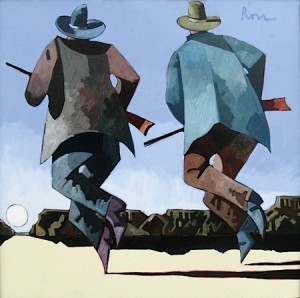
Two Men Running With Rifles
The post Thom Ross Reimagines Custer, Wyatt Earp and the Old West appeared first on .
January 2, 2015
Behind the Gates of Gomorrah: An Insane Situation.
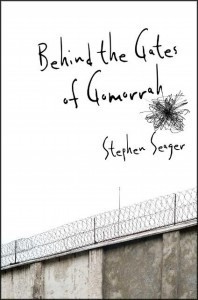 Dr. Stephen Seager’s memoir, Behind the Gates of Gomorrah: A Year with the Criminally Insane, may be the most important book published in the last ten years.
Dr. Stephen Seager’s memoir, Behind the Gates of Gomorrah: A Year with the Criminally Insane, may be the most important book published in the last ten years.Seager, a psychiatrist at Napa State (forensic) Hospital, in California, has told America two things it very much needs to know.
One: Mass shooters are primarily paranoid schizophrenics.
Two: Forensic hospitals house violent criminals, including serial killers and child molesters, and those patients are free to mingle with staffers and each other.
Therefore, forensic hospitals are the most dangerous places in this country, both to patients and staffers.
Gomorrah is also a fantastical, almost surreal book that I found hard to put down, rubbing my eyes at 3 a.m.
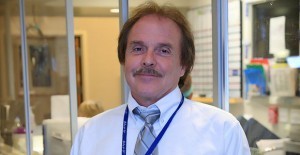
Stephen Seager
Seager has changed names to protect privacy.
Dr. Seager, thank you for the interview.
Q. You began the book with the character you called Boudreaux (who was hospitalized after walking into the place he worked and gunning down his former co-workers) cornering you and threatening to kill you, calling you a “bloodsucker.”
Then when you briefly talked to him, he snapped back to sanity. He said he had killed his closest friends, and “What kind of a man does that?”
How can the insane snap back to sanity so fast? How does it happen?
A. As it turned out later, Boudreaux suffered from what’s called a “delirium” meaning he was actually medically ill. People who suffer from delirium frequently have florid symptoms of psychosis (think of DT’s – delirium tremens) when people withdraw from alcohol.

Dr. Richard Frishman, a psychiatrist at Napa State Hospital, photographed after he was attacked by a patient.
But delirium can be caused by many things – infections, drug intoxications and withdrawal just to name a few.
Another hallmark symptom of delirium is a rapid shifting from psychosis to normal, which proved to be the case with Boudreaux.
Q. The character you call McCoy is a career criminal, who killed somebody in the hospital. You say he isn’t mentally ill. Then he threatened to kill you because you testified against him in court, to keep him in the hospital.
Is McCoy still at Napa State?
A. Yes. But testifying against your patient and then having to care for them again is a frequent occurrence, certainly not limited to McCoy and I.
Testifying against a patient is the single most dangerous thing a psychiatrist at a state hospital can do.
Q. You say all forensic hospitals are full of violence, patients against staff, and patient against patient. How did the United States put itself in this position?

Napa State staffers, in 2011, protesting violence at the hospital, following the murder of psychiatric technician Donna Gross and the beating of rehabilitation therapist George Anderson
A. During the 1960’s, a series of court decisions seriously restricting the grounds for involuntary admission to a mental hospitals coincided with President Kennedy championing the 1963 “Community Mental Health Centers Act (CMHCA)” which easily passed congress.
The CMHCA was based on the premise that if mental illness could be attacked early and in the community, that chronic mental illness could be prevented and state mental hospitals would no longer be needed.
This sweeping change was not based on a single shred of scientific evidence and, tragically, has proven to be a total disaster.
Based on the wishful thinking of the CMHCA, state mental hospitals were essentially emptied.
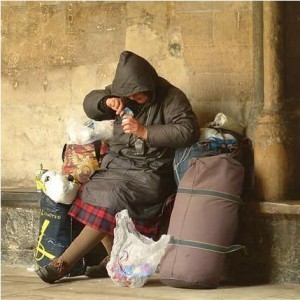 The released patient’s got no better in the community – whether treated early or not – and became the homeless mentally ill that we so often see, sick and dying on the streets of American big cities today.
The released patient’s got no better in the community – whether treated early or not – and became the homeless mentally ill that we so often see, sick and dying on the streets of American big cities today.State mental hospitals with lots of empty beds (then) decided to take in “forensic” patients. Those people who had both committed crimes and were mentally ill.
Specifically to answer your question: few Americans actually care what happens to the mentally ill.
Whether these sick individuals are assaulted in state mental hospitals or whether they die on the streets, doesn’t seem to really much matter.
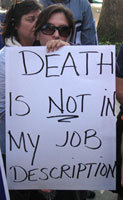
Napa State employees protesting violence at the hospital.
It’s been going on for decades: Did you know about it?
Q. Why have you stayed at Napa?
A. I stayed at Napa because my patients, who absorb most of the abuse and beatings, and the staff – mainly female nurses – really have no voice. No TV cameras, radios, newspapers, documentary film makers or anyone has ever been inside Napa State Hospital.
The BBC has tried. The New York Times has tried, 60 Minutes has tried, and they have all been stonewalled.
Forensic mental hospitals are shrouded in a conspiracy of silence.
My book gives my patients and staff at least one voice. If I had quit, my book would have been easily discounted. But since I’m still there, their voice is still there.
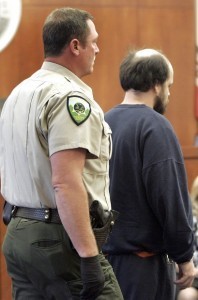
Jess Willard Massey, the Napa State Hospital patient who murdered psychiatric technician Donna Gross, is led out of Napa Superior Court following his 2011 sentencing. Massey was sentenced to 25 years to life.
Q. You say all mass shooters are (primarily) paranoid schizophrenics.
Why doesn’t everyone know about this and why hasn’t law enforcement done something about admitting all paranoid schizophrenics to a hospital?
A. Here’s some figures: 1% of the population everywhere on earth is schizophrenic so in the US that’s 3.25 million people of which maybe 1 million or so are paranoid. There are 50,000 state hospital beds nationally.
The real question is why aren’t they in mandatory out patient treatment?
People know about mass shooters and they know about mental illness but nothing is ever done, which you have noticed. If you figure out why that is, please let me know.
When I said that people don’t care about the mentally ill, I wasn’t kidding.
Q. Is the U.S. more concerned about individual rights than mass murder? Why?
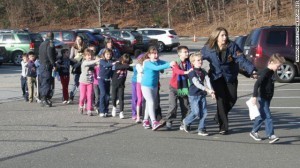
Sandy Hook Elementary, Newtown, Connecticut, 2012
A. For the past fifty years, US courts have been clear that individual “liberty” interests trump pretty much everything else. Including, apparently, mass murders.
For American courts, it’s a bigger deal to force someone to take a shot once a month in the arm against their will than to gun down two dozen first grade students in an elementary school.
Q. What causes paranoid schizophrenia? Brain chemicals? Then why do all paranoid schizophrenics have the same symptoms?
A. Schizophrenia is a medical illness which has a variety of symptoms – as do most illnesses. One of the symptoms is delusions. Delusions are beliefs impervious to reason.
People who have schizophrenia and are primarily delusional are called paranoid schizophrenics.
Schizophrenia is a genetic disorder that produces abnormal brain chemistry. All disease groups have the same symptoms. Like all types of pneumonia pretty much produce fever and cough.
All paranoid schizophrenics have paranoid delusions by definition.
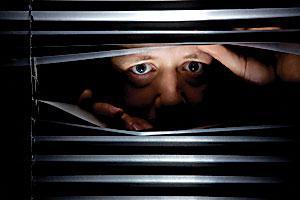
Q. As you noted in the book, many psychologists and psychiatrists do not believe in psychiatric drugs. They deny there’s evidence chemicals in the brain cause mental illness (and some deny there’s any such thing as mental illness).
Yet you believe in their effectiveness?
A. There is no serious debate about the efficacy of modern psychiatric drugs. There are remnant groups – left over from the days of Freudian analysis and the “Anti-Psychiatry Movement” of the 1960’s – who still infect mental health policy, unfortunately at some of the higher government levels.
If I stated that there was any serious doubt about psychiatric medications among the vast majority of psychiatrists and psychologists practicing today, I have given the wrong impression. There are a few well-placed hold outs, but they will pass.
Q. You began one chapter quoting a story in the Bible regarding possession. Do you believe such a thing exists?

Courtyard at Napa State
A. No. But I come from a religious background. I was born in Utah. I am a seventh generation descendant of Mormon pioneers, so I understand that many people do believe this and that’s okay.
What’s not okay is when people try to “exorcise” the demons from the mentally ill or see mental illness as “sin” – as was common in Medieval times.
People once thought pretty much all disease was caused by demons or was sent as a punishment from God.
Unfortunately, this stain tends to linger on the mentally ill, along with many other myths.

Q. You say it’s easy to forget any particular patient is a mass murderer or child molester, and some of your closest friends are mass murderers. Can you tell us more about that?
A. As a physician, you have a natural affinity for the patients entrusted to your care. You can’t help it. My patients and I are locked in together all day almost everyday. I like a lot of them. A lot of them are murderers.
It makes me uncomfortable when I think about it, but that’s the way it is.
 Q. You said a majority of doctors who work in America’s forensic hospitals are foreigners. How do they do at places like Napa? Do they experience it any differently?
Q. You said a majority of doctors who work in America’s forensic hospitals are foreigners. How do they do at places like Napa? Do they experience it any differently?A. I’m not exactly certain how they experience it but they get traumatized by all the violence just like everyone else.
The reason foreign doctors are over represented at state mental hospitals is because most American doctors won’t do it. It’s the same reason inner city clinics are populated by international physicians as well.
Americans don’t care about the mentally ill, so we have out-sourced their care.
Q. You repeatedly talk about the violence (including the doctor who was murdered and the attempted rapes and assaults). How many acts of serious violence have occurred at Napa since you began working there?
A. Hospital administration will admit to 3,000 assaults per year on patients and staff. I think the number is probably higher. I’ve been at Napa for four years so that’s 12,000 assaults.
Q. The character you called McCoy has “Hell” tattooed on his forehead. That seems about right. Can you tell us more about this?
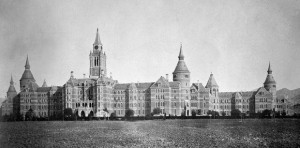
One of the first buildings at Napa State, since demolished.
A. You picked up on the same theme as The New York Times. They entitled my Nov 11th Op/Ed piece,”When Hell is the Other Patients.”
One of the first things a veteran nurse called Napa when I first began working there was, “Thunderdome,” which is about right.
HYPERLINK “https://mail.google.com/mail/u/0/h/t5...” – Show quoted text -
The post Behind the Gates of Gomorrah: An Insane Situation. appeared first on .
December 6, 2014
William the Conqueror’s Texas Christmas–A Short Story
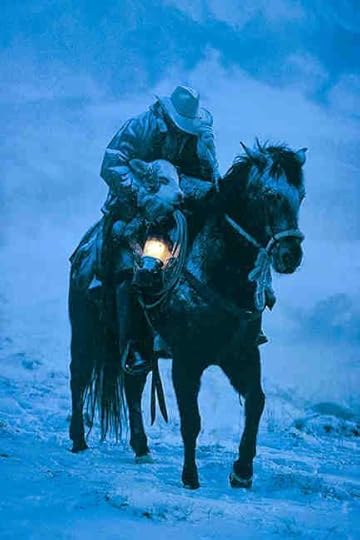 Daddy died when I was twelve, when we was ranching near Buffalo Gap.
Daddy died when I was twelve, when we was ranching near Buffalo Gap.A norther blowed in off the plains and Mama, Daddy, us two boys, and Big’un, my dog, hugged the fireplace.
After awhile, Daddy said he had to check the stock.
When he didn’t come back, me (William), and my brother Jim, sixteen, saddled up and went looking.
His horse must have fell because when we found him, Daddy was laying on the ground, all broke up.
That ole son-of-a-gun he rode stood next to him like he didn’t give a toot what happened to Daddy.
We rigged a litter with Daddy’s saddle blanket and dragged him back to the dugout.
Mama didn’t holler. She kind of squinched up her eyes and pressed her lips.
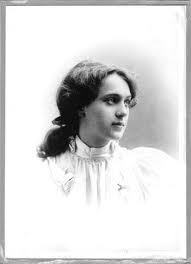
Mama
She just set next to the bed holding Daddy’s hand, whispering, “James, don’t leave us, don’t leave us.”
I knowed things was bad because when we found him, Daddy’s mustache looked like a iced-over mesquite bush and his chest sounded like a billows.
Come morning, mama still held his hand, but Daddy laid quiet as quiet could be.
It was too far to go for the preacher, but we sang Mama’s favorite hymn, “Jesus Loves Me.”
Men don’t cry. But I just wished me and Jim had gone out with Daddy that day. I wished it real hard.
Onct Daddy was in the ground, Mama said to build a cage for the hens and pack the wagon. We was leaving for Aunt Winnie’s cotton farm near Jefferson.
Me and Jim took turns with the herd ever night and we had to drive them ornery critters all day. My eyes got so scratchy I like to fell off Sweet Girl, my mare.
When we come to the cabin in the piney woods, wasn’t nobody there. Uncle Wallace and Aunt Winnie done gone.
“Never mind,” Mama said, and sat on Aunt Winnie’s porch for a think.
Here we was, two days before Christmas and we didn’t have nuthing; no Daddy, no food, no beds.
I felt like cussing God.
“I’m gonna kill a hen,” I told Mama.
“Oh no you’re not, we need those hens for eggs,” she said, and that was the end of that.
Christmas Eve, we hadn’t had nuthing to eat except them ole eggs and Jim had one bullet left for Daddy’s Winchester.
“I’m going to visit the neighbors,” Mama said. “Maybe they know where our folks have moved.”
“Mama. Don’t worry, we’re going hunting,” Jim said, taking our one bullet from Daddy’s Winchester and staring at it.
Finally, he chambered the shell and said, “let’s go.”
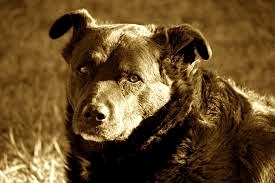
Bigun
Me, him and Big’un set out.
It was a foggy-like morning. The air was wet on my face and hushed. It was kind of like walking through a graveyard.
Getting to the creek, we lay down to watch.
Nuthing come.
Twilight, and we was still laying in them wet leaves feeling our stomachs scrunch up.
That’s when we heard it.
I thought it was a dream.
It was Daddy’s voice.
Looking to the side, I saw our Daddy standing right by us.
I mean, it was him. There weren’t no fog showing through him. He wore his ole red plaid shirt I seen a hundred times, his sheepskin jacket, his boots, his hat.
You wouldn’t think a ghost would need boots and a hat.
When Daddy smiled at me, I like to have died myself.
Grabbing my arm, Jim said, “Daddy?”
We had laid him in the grave and here he was.
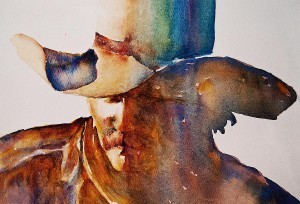
Rainbow cowboy by Jani Freimann
Reaching down, Daddy pulled us up and it felt just like him.
Before we knowed it, we was hugging and Big’un was dancing around barking.
“Boys, I hated to leave you,” Daddy said. “No man has better sons.”
Me and Jim bawled, even though we was men.
Daddy held us tighter.
“Jim, William, I came back because you need some help. I’m going to get you all something to eat. And I’m sending some more help tomorrow,” he said.
I rubbed my face on Daddy’s jacket and it was real. It even smelled like his cigars.
“I want you boys to remember, all your life, your father loved you so much he came back to help you when you needed it most. Will you remember that?” Daddy said.
We nodded against his jacket.
“And will you take good care of your mama?”
“Course we will,” I said.
“Daddy, where you been?” Jim asked, in his serious way.
I looked up and Daddy smiled, his eyes all crinkled.
“I’ve been across the river,” he said, “where the grass is high and the water is sweet. Someday, we’ll all be there together, and won’t we have a time!”

“Daddy, don’t leave us,” I said, begging him.
“I’ve got to go boys.”
After hugging us one more time, we wasn’t holding on no more. Daddy was standing off, looking at us.
“Follow me,” he said.
So there we went, seeing his broad back in front of us.
Dark almost come down when Daddy stopped and pointed.
A buck with antlers as long as a tree limb was sipping from the spring.
The buck looked right at us, but he didn’t even twitch.
Throwing his Winchester up, Jim squeezed off the nicest shot. He hit the buck right behind the shoulder and that critter hit the ground like he’d been pole-axed.
We whooped.
Then we remembered Daddy. He was gone.
My heart like to have dropped out of my chest.
Jim stared down at the leaves. He sighed and said, “Come on Tadpole.”
Being as how we had already had the best Christmas present you could ask for, you wouldn’t think something scary would happen.
But two of the most slavering gray wolves you ever seen creeped out from behind a tree.
Them lobos wanted our buck.
Jim and me wasn’t going to let them varmints have our meat, no sir, so Jim shouted “hiya, git, hiya, git,” and I picked up a stick.
Still, them wolves kept on coming. My knees was shaking.
 Bigun saved the day. He lit in to them lobos like a fury. The whole thing looked like a rolling ball of fur.
Bigun saved the day. He lit in to them lobos like a fury. The whole thing looked like a rolling ball of fur. Jim grabbed my stick and he laid it on big, but the devils turned on him, showing their bloody teeth.
Here’s the next big happening.
A light, shining like a torch, spun round Big’un and the wolves and the wolves took off running.
My Big’un. He lay on the ground whining, but he was just scart. He was a good ole boy.
It took us awhile to drag the buck back to the cabin and Jim took to looking at me saying, “Did you see all that?”
We never tole Mama. We figured she wouldn’t believe us. I didn’t know if I believed it myself.
Me and Jim gutted and skinned the buck, and we had venison on the fire before the buck was even cold.
I et til I bust.
Mama said she couldn’t find the neighbors, but we was feeling a whole lot better when we laid down in our blankets.
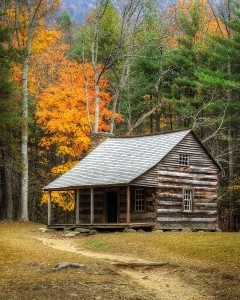
When we woke up, it was Christmas!
Me and Jim went out and picked a little cedar tree and Mama put pine cones on it and some red ribbon.
About when we was ready to have more venison, we heard voices outside.
A wagon pulled up and out come a family. They had canned stuff for us, and cornbread and even a dried apple pie.
Turns out, a stranger had rode by their cabin that morning and said a widow and her kids lived about a mile away and needed some help.
The man come by had a mustache and wore a red plaid shirt.
Them folks said they was sorry they didn’t have presents for us. But they did.
They was the present.
We had Christmas dinner and we sang “Silent Night” and “Joy to the World.”
Both us boys got something special.
Mama took us into a room by ourselves and told us the secret names Daddy called us, when he and Mama was talking alone.
“William,” Mama told me, “before you were even born, your father called you William the Conqueror, because he said you would be brave and strong.”
Jim grinned for days after Mama told him his secret name, but he never tole me what it was.
Life sort of settled down after that. Mama found where Aunt Winnie and Uncle Wallace got to and she wrote’em a letter. They come got us.
Mama taught school and she tried to teach me to talk right, but William the Conqueror is his own man.
After a while, Jim and me moved back to Buffalo Gap and rounded up the mavericks. We drove’em to Kansas and made a heap of change.
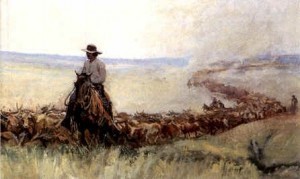
We had a lot of Christmases after the one I told you about, but I never had a better one.
It’s been fifty years since Daddy came back and I hope to see him again.
I been thinking a lot lately about that place he told us about, where the water is sweet and the grass is high.
The post William the Conqueror’s Texas Christmas–A Short Story appeared first on .
November 14, 2014
Why We Write About the Old West
 Writers who write about the Old West are a different breed.
Writers who write about the Old West are a different breed.A majority of readers love romances, mysteries and/or thrillers, fantasy, horror, and a host of others.
In comparison, historical novels about the West (or Westerns) are not that popular.
Yet, we keep writing about Tucson and Tucumcari, Deadwood and Dodge, Indian fights and gunfights.
I’ve asked three other writers why they do it, and my comments are at the bottom.
Here are confessions by Patricia Grady Cox, Johnny Boggs and Anthony Whitt.
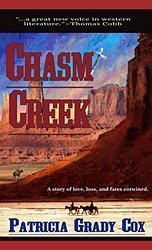
Patricia lives in Phoenix, Johnny lives in Santa Fe, and Anthony lives in Austin.
Patricia – I once thought I would write a novel set in contemporary times. It started out in the city and then, next thing you know, the characters are all driving out to an old ranch the family owns. I think it was somewhere around Payson.
A monsoon strikes. A pregnant woman is discovered dead, obviously murdered. The phones are out – landline doesn’t work, no cell tower nearby. The arroyos flood, no way to drive to town for help.
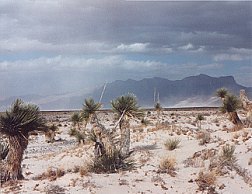
photo by Johnny Boggs
There’s a plane but the wind . . . and, of course, the power goes off.
At about this point, I realized I had taken my city slickers and put them smack dab in the middle of the wilds of Arizona with no way to get help and nobody to rely upon but themselves, while somebody who wants to do harm is in the vicinity.
In other words, the old West.
I figured I may as well stick to writing historical fiction set in the American West, which is how I describe my novels, and which is the only time and place I ever wanted to write about.
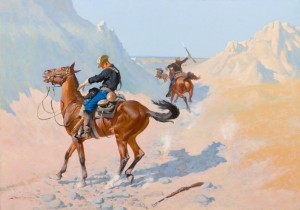
by Frederic Remington
As in modern-day Payson during a monsoon, nobody is coming to help my characters out of whatever trouble they’re in. And there is always somebody (or something)–outlaw, Indian, revenge-seeking stranger, lawman, rattlesnake–who wants to do harm.
When I started writing novels, it didn’t even occur to me to write about anywhere else. Even when I try, that’s where I end up.
 My soon-to-be-released novel,
Chasm Creek,
is set in 1880 Arizona Territory, partly near the Verde River and Fort McDowell, partly on the Navajo reservation.
My soon-to-be-released novel,
Chasm Creek,
is set in 1880 Arizona Territory, partly near the Verde River and Fort McDowell, partly on the Navajo reservation. My second novel, in an agent’s hands, takes place in and around Prescott when it was the Territorial capital.
My third novel, just begun, is partly 1879 Flagstaff and partly modern times – but those modern times are set in a living history museum that portrays, yes, territorial Arizona.
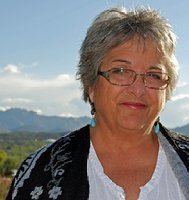
Patricia Grady Cox
And while a future novel, in a beginning draft stage, has a timeline that goes up to 1945, the heart of the book is in Camp Verde, Arizona, in the 1870s.
“Write the book you would want to read” is my north star. And what I want to read is a story that is set in the 1800’s American West.
Johnny Boggs – You want me to be honest? Quite a few of my early published short stories were contemporary Southern pieces, some of them partly autobiographical, certainly personal.

Johnny, with his son Jack
I just found it a lot easier not to piss off my family by writing Westerns, where I can disguise some of those personal or autobiographical elements.
 And, of course, I’ve always loved the West and U.S. history.
And, of course, I’ve always loved the West and U.S. history. Besides, I’ve lived more than half of my life now in the West. It fits me better than the South, though I do love she-crap soup, shrimp and grits and vinegar-based barbecue pig meat.
Anthony Whitt – I grew up hearing about an Indian raid on my great-great grandfather’s homestead on the Colorado River west of Austin.
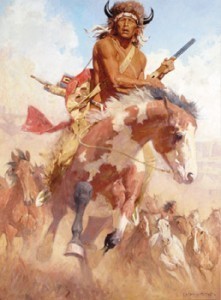
Horse Raid, by David Mann
He was a well known Texas Ranger and sergeant in the Civil War.
The tale always fascinated me, and I set out to write a fictionalized short story about the event, unaware of where the decision would lead.
After receiving early praise, the short story transformed into a full-length novel that needed room to grow. As a result, the decision to write a short story became a life changing moment that gave birth to the Hard Land to Rule Trilogy.
The allure of the Texas Hill Country has always exerted a strong pull on my imagination. I can still visit the old homestead and picture in my mind’s eye the Comanche lurking on the ridge overlooking the site of my great-great grandfather’s cabin.
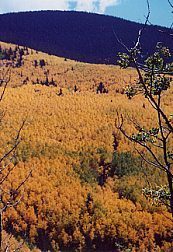
Photo by Johnny Boggs
If I listen closely, I can hear the men scrambling around the cabin in the early morning darkness while they prepare for the pursuit of the raiders.
There is still a sense of the Old West in the cut up canyons and cedar breaks where my grandfather used to point out the Indian trails he remembered seeing as a young man on horseback.
This harshness of the landscape intrigues me, makes me attempt to capture, in words, the character of the frontiersmen who carved out a living in those trying circumstances.
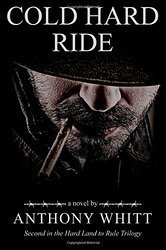
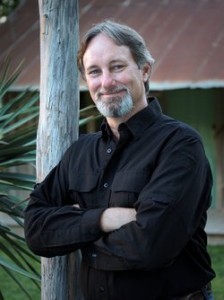
Anthony Whitt
The settlement of these remote lands created dramatic clashes between opposing cultures and tested the mettle of men in ways we now struggle to comprehend.
In short, the Old West possessed the perfect combination of conditions to illustrate both the good and the bad side of people caught up in the taming of a vast wilderness.
Julia Robb – I write Historical novels about the West because I didn’t enjoy the 20th century and I don’t enjoy the 21st.
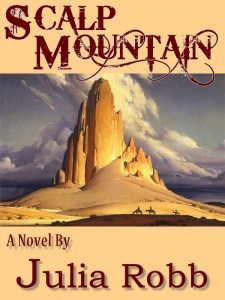 American culture (I can’t speak for other cultures) is a peculiar combination of horror and boredom.
American culture (I can’t speak for other cultures) is a peculiar combination of horror and boredom.On one hand, armies behead their enemies, or crucify various and sundry, while disease threatens, and we fight each other to the death in the halls of Congress.
But this happens thousands of miles away (or in that snake den, Washington) while we sit in front of our TV’s watching twenty-four hour news and munching supper.
We don’t risk our lives, but fill the emptiness with Netflix, video games, sports, Mad Men or whatever poison happens to catch our fancy.
In the West, pioneers staked everything on a homestead in Indian Country, or a mine, or a saloon, or a battle at the Little Big Horn River.
It was a bigger place than the one we live in.
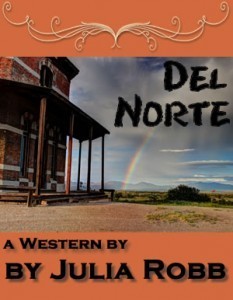
Of course, this had its drawbacks.
It was so easy to die of cholera, or scream your lungs out while Comanche burned you to death, or just break your leg so far from the cabin you couldn’t get back before gangrene set in.
Personally, I would rather take my chances on the West.
And speaking as a writer, that’s just what I’ve done.
The post Why We Write About the Old West appeared first on .
October 4, 2014
Rebel Yell and Comanche Moon: Sam Gwynne Speaks.
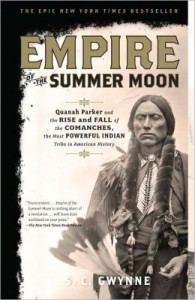 Hi S.C. Gwynne (better known as Sam Gwynne): Thanks so much for talking to me. I’ve admired you for years, since I read Empire of the Summer Moon: Quanah Parker and the Rise and Fall of the Comanches, the most Powerful Indian Tribe in American History.
Hi S.C. Gwynne (better known as Sam Gwynne): Thanks so much for talking to me. I’ve admired you for years, since I read Empire of the Summer Moon: Quanah Parker and the Rise and Fall of the Comanches, the most Powerful Indian Tribe in American History.Not only do I admire the job you did with Empire , I’ve recommended the book to many people and they’ve always been amazed at how good it is.

Sam Gwynne
Now I’m reading Rebel Yell: The Violence, Passion, and Redemption of Stonewall Jackson (just published readers) and enjoying it.
So let me begin with Empire.
Q. Many authors who write non-fiction histories of tribal peoples fail to mention some of the more unpleasant aspects of each tribe; such as torture, raping captive women, etc.
 You didn’t do that. You were honest and complete.
You didn’t do that. You were honest and complete.Was your honesty a conscious decision on your part?
Were you apprehensive other writers, pundits or tribal peoples would attack you for that same honesty?
A. Fortunately I was too naïve to know any better. I just approached it objectively, and objectively that is what happened. There is no denying it.
What was even more surprising to many people versed in the ideas from Bury My Heart At Wounded Knee and other books was that American Indians were not always victims.
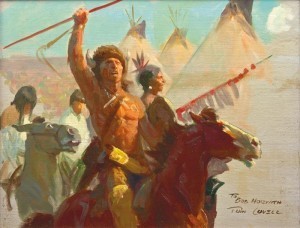 Comanche Moon, Study, by Tom Lovell.
Comanche Moon, Study, by Tom Lovell.
It is true that they got steamrolled by the westward rolling American empire, but they were not always victims or losers.
The Comanches were immensely powerful and, yes, in Anglo-European terms (though not in theirs), cruel.
Q. Have you ever been attacked in print, or at a conference?
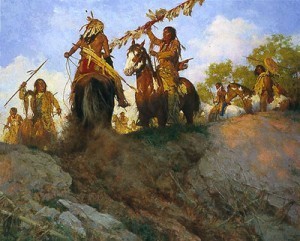
Sunset for the Comanche, by Howard Terpning
A. No. I have been waiting for it, though.
Native Americans have many different opinions about the book. Many are positive. Some do not believe that a white historian like me should write a book like this.
I fully respect their opinions, though I do not agree with them.
Q. You didn’t create good guys and bad guys in the book. How do you personally feel about the war between the white settlers and the Comanches?

Texas Rangers, who often fought Comanches
A. I feel that it is impossible to get to a moral place where you can say “this is good,” and “this is bad” in absolute terms. It would be just as hard to do that today in the Middle East.
Who is to blame?
Texans had a deep, abiding hatred for Comanches, who returned it in kind. I tried my best just to be a fair observer…..My background is largely as a reporter. The idea of fairness is very important to me.
I can find you a white atrocity for every recorded Indian atrocity.
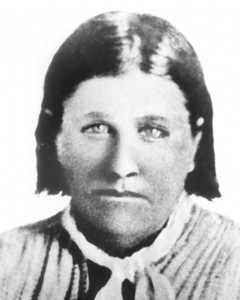
Cynthia Ann Parker
Q. You seemed to feel a great deal of sympathy for Cynthia Ann Parker, writing you like to think of her, “On the immensity of the plains, a small figure in buckskin bending to her chores by a diamond-clear stream. It is late autumn…Above her looms a single cottonwood tree, gone bright yellow in the season, its leaves and branches framing a deep blue sky. Maybe she lifts her head to see the children and dogs playing in the prairie grass and, beyond them, the coils of smoke rising into the gathering twilight from a hundred lodge fires. And maybe she thinks, just for a moment, that all is right in the world.”
Beautiful. Poignant.
Can you tell me more about how you felt while researching Cynthia Ann?
A. She is one of the most tragic figures of the American west.
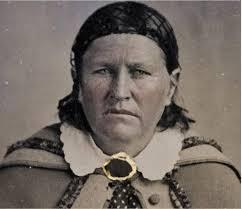
Cynthia Ann
She was kidnapped in a brutal raid, then adapted brilliantly to a new society, learned the language, married a powerful war chief, bore three children.
The cruel irony is that she was asked to adapt twice, the second time after she was taken in the 1860 raid and given back to her white family. She was unable to do that.

Ghost Dance by Howard Terpning
She became a pariah, was moved ever farther from the plains. I feel immensely sorry for her.
Q. After reading the book, I came to admire Quanah Parker. He was successful in the Comanche culture and he was successful in the White culture.
He did not seem to feel sorry for himself.
Do you also admire him?
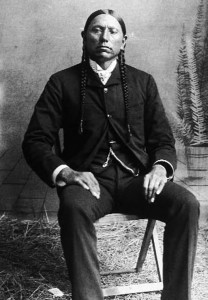
Quanah, in mid-life
A. Quanah was a great man, and proof that there are second acts in American lives.
That one of the greatest plains warriors later started a school district and testified brilliantly for Indian rights in Washington is one of the most amazing things I have ever heard.
Q. Many biographies have been written about Stonewall Jackson. Why were you attracted to this subject?
A. The idea of transformation.
In 14 months he went from being an obscure, eccentric physics professor who was the worst teacher anyone had ever seen to being the most famous military man in the western world.

General Jackson
I rest my case.
Q. Your Rebel Yell subtitle reads, The Violence, Passion, and Redemption of Stonewall Jackson.
Redemption? Do you believe he needed redemption? Do you believe Gen. Jackson himself believed he needed redemption?
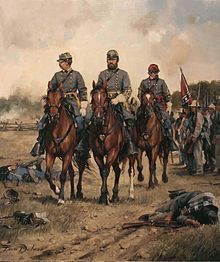
A. He did not require redemption from sin, unless you consider fighting for the Confederacy a sin.
I meant redemption from the ordinariness and failure of his life.
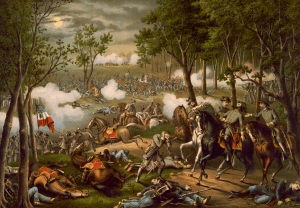
Battle of Chancellorsville by Kurz and Allison (depicts the wounding of Confederate Lt. Gen. Stonewall Jackson on May 2, 1863)
He was just a bad physics teacher when the war started. He would have been a preacher if he had had any sort of people skills or ability to speak in public or if he hadn’t been so shy.
He had left the army under less than idea circumstances.
He then becomes a war hero and the driving force behind the great waves of revivals that swept the Confederate army in the winter of 1862-3.
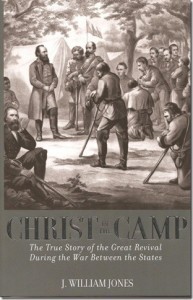
Redeemed from his own inadequacies, perhaps. Brought back to an earlier state of grace.
Q. Stonewall was a strange man, seemingly two people in one body, an eccentric professor who couldn’t teach or relate to people, and a mighty and brilliant warrior.
What do you think about this contradiction?
A. I think it is why I wanted to write the book in the first place and the book itself is the answer to the question.

Jackson and Robert E. Lee meeting for the last time

Sherman
Q. One of the blurbs about the book calls Jackson an “American hero,” a characterization William T. Sherman might argue with.
How can a man fight against the Union and yet be an American hero?
(By the way, my three-times great-grandfather fought with the Confederacy and was killed at the Battle of Kinston, N.C.)
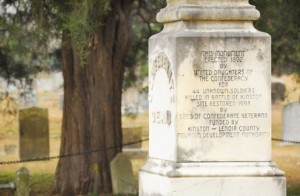
Memorial for unknown Confederate dead, Kinston, N.C.
A. A good question and well put. I am trying to reclaim Jackson as a true American hero and not just some crazy/brilliant Confederate.
He went to West Point and fought with amazing bravery for his country in the Civil War.

A young Stonewall
He was a patriot. He was widely admired in the North during his life and after his death for his bravery, his humility and his Christianity.
I am just trying to get back a little of that genuine feeling.
Q. Many African-Americans feel a horror for the Confederacy. You obviously do not. Why?
A. There is no doubt that slavery was a great evil in this country. I think most of us do feel horror and shame when we watch a movie like Twelve Years a Slave.
But I do not feel horror at the mere idea of the Confederate nation.
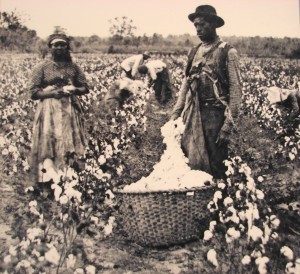 In my book I write about Jackson’s many intersections with slavery and how they influenced his life.
In my book I write about Jackson’s many intersections with slavery and how they influenced his life. He owned slaves. He founded and ran a Sunday school for slaves in Lexington, in defiance of a Virginia law that said you could not teach African Americans the Bible.
When he fought his Valley Campaign it was the first time slaves crossed through Union lines in large numbers.
Q. I know many Southerners who fought for the Confederacy weren’t fighting for slavery, but because Northern armies were invading their states.
But in the end, wasn’t the war ultimately about slavery?
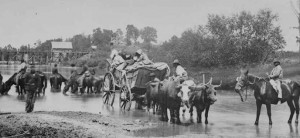
Fugitive Slaves Crossing the Rappahanock River in Virginia, 1862.
(Library of Congress)
A. Yes, absolutely. But it was not entirely about slavery in the beginning, particularly for people from Virginia, like Jackson and Lee.
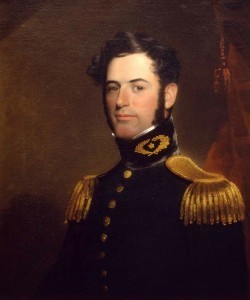
Robert E. Lee 1838
Q. I’ve read other Jackson biographies and came to feel Jackson had a spiritual conflict about fighting against the Union.
I’m only 20 percent into Rebel Yell , so I don’t know what you believe about that.
A. Just before the war started, Jackson worked hard to prevent it. He thought it was ungodly, a monstrous evil. He even tried to organize a national day of prayer to avoid war.
But once it started his goal was to kill as many Yankees as he possibly could.
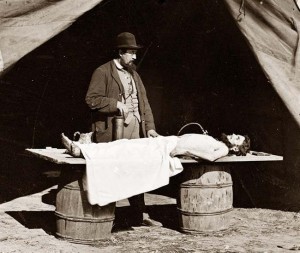
Embalming the dead
One of his ideas early in the war was to march north and burn Baltimore and Philadelphia and Pittsburgh. He even briefly advocated a “black flag” war, giving no quarter.
So I guess there might be two answers to the question. He is a fascinating and complex person.
Q. What are you working on?
A. Right now all of my efforts are going into a two-month book tour that will take me to 15 cities. I have barely time to get my dry cleaning done.
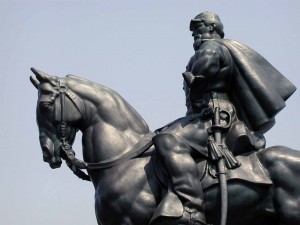
Statue of Stonewall, Manassas, Virginia
The post Rebel Yell and Comanche Moon: Sam Gwynne Speaks. appeared first on .
September 20, 2014
An interview with Julia Robb by Colin Falconer
 Julia and I have never met and we don’t even always see eye to eye on things, but I love her take on life and I am a huge fan of her work.
Julia and I have never met and we don’t even always see eye to eye on things, but I love her take on life and I am a huge fan of her work.Scalp Mountain was one of the best books I read last year, and I’m not a huge fan of westerns. Her style reminds me of Annie Proulx, spare prose without sentimental or romantic ideas of the American West. If you like Proulx or Cormac McCarthy, you’ll love Julia’s work.
So Julia … tell me something about Julia Robb that no one else knows.
JR: I am convinced the human race is insane.
I was a reporter for twenty years. I once wrote a story exposing a political candidate’s past life, his bankruptcies, various kinds of lies the man told the public and charges filed against him in court.
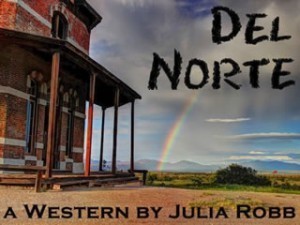 The day the story ran, he walked into the news room. We all froze, thinking he was going to start shooting.
The day the story ran, he walked into the news room. We all froze, thinking he was going to start shooting.Instead, he shook my startled editor’s hand, thanking him for the “great story.” He meant it. A few months later, he went to a public place and shot himself.
On the other hand, human beings can be so good. I was working for a paper in South Texas and they told me to drive around the countryside and report on “the rural poor.” There are a lot of rural poor in South Texas, which is thousands of square miles of creosote, scrubby mesquite trees, scorpions and rattlesnakes but not many people.
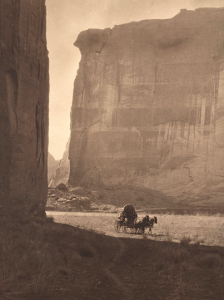 I stopped in Mirando City (population 400) to get a hamburger and started talking to the waiter and restaurant owner and cook (all one person)! He told me a few years earlier the town had been on its last legs, it was running out of water. People were closing up and moving on.
I stopped in Mirando City (population 400) to get a hamburger and started talking to the waiter and restaurant owner and cook (all one person)! He told me a few years earlier the town had been on its last legs, it was running out of water. People were closing up and moving on.But two brothers who owned a machine supply company, bought out the water company, paid to fix the town wells, then sold the water at cost. They then went to Austin and got a law passed to make it easier for people to buy town lots. They saved that town.
The contrast between human craziness and human goodness fascinates me.
CF: Your writing has been favourably compared to Cormac McCarthy. Not an unflattering comparison! Is he a hero of yours?
JR: I believe “All The Pretty Horses” is one of the best American novels, and one of the characters in “Horses,” Jimmy Blevins, is one of the all-time great characters.
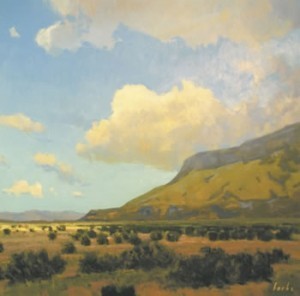 But I have not cared for McCarthy’s other novels because they are so nihilistic. I do not find redemption in McCarthy’s work and that’s one of the qualities I try to insert into all my books. I believe the world is tragic, but I believe situations and people can be redeemed and life would be truly empty and sterile if that weren’t true.
But I have not cared for McCarthy’s other novels because they are so nihilistic. I do not find redemption in McCarthy’s work and that’s one of the qualities I try to insert into all my books. I believe the world is tragic, but I believe situations and people can be redeemed and life would be truly empty and sterile if that weren’t true.CF: With so many women writing contemporary romance, you stand out from the crowd with tough, gritty novels about Texas. You’re invading Annie Proulx territory and you do it so well. Where do you find your inspiration?
JR: Writers pull from their unconscious and we don’t necessarily know where we get the stories. That said, I have lived in South Texas, where “Saint of the Burning Heart” is set and many of the people and situations in the book are based on people and situations I observed there.
 I was on the scene when the “patron” system was dying – it’s also based on the conflict between Anglos and Hispanics that raged in Texas for a generation. As for Nicki, who will not give up on making Frank Kendell love her again … maybe that came from my personal life.
I was on the scene when the “patron” system was dying – it’s also based on the conflict between Anglos and Hispanics that raged in Texas for a generation. As for Nicki, who will not give up on making Frank Kendell love her again … maybe that came from my personal life.“Del Norte” happened because I got fascinated with Civil War POW camps and began wondering how that experience would affect both the prisoners and their jailers. And since everyone already knows about Andersonville, the Confederate camp for Union prisoners, I set mine in Elmira, the Union camp for Confederate prisoners.
As for Scalp, I grew up in West Texas, where the West and the Indian Wars are still real to people.
CF: I remember reading an excerpt from Scalp Mountain about your character, Lohman. He’s not the hero of the novel but he intrigued me straight away, so I went on to Amazon and bought the book. A fascinating portrayal – who inspired him?
 JR: I can honestly say I have no idea where Lohman came from, but I learned to love him; his passion and secret bitterness, his debonair manner, his culture, self-possession and good looks. He’s an educated man among uneducated people. But, I also have so much compassion for him.
JR: I can honestly say I have no idea where Lohman came from, but I learned to love him; his passion and secret bitterness, his debonair manner, his culture, self-possession and good looks. He’s an educated man among uneducated people. But, I also have so much compassion for him.What would it be like to be sexually fixated on another man in the nineteenth century west? Not good. He’s a tragic man. He could have done and been so much, but he has a problem.
CF: They say all novels have a pivotal point where the reader just can’t put the book down. Where is that point in Scalp Mountain and Saint of the Burning Heart?
JR: Readers tell me they can’t put Scalp down after Jose Otero kidnaps Clementine.
I personally got most involved in the scenes between Lohman and Colum; especially when they’re alone together at the Rio Grande River with a fretful baby, and when they come back and take bathes and wear new clothes so they’ll be clean when they fight to the death.
I also enjoyed writing about Henry’s Texas Ranger career. Henry is an interesting combination of deadliness and sweetness.
CF: And right from left field: what’s your idea of a fun Saturday night?
 JR: I’m an extremist. I would ideally begin Saturday night on Saturday morning by riding bicycles with a friend, then going to a good Thai restaurant for lunch, playing poker or forty-two all afternoon (forty-two is a Texas domino game), then going to a movie and then go out dancing. Whoopee.
JR: I’m an extremist. I would ideally begin Saturday night on Saturday morning by riding bicycles with a friend, then going to a good Thai restaurant for lunch, playing poker or forty-two all afternoon (forty-two is a Texas domino game), then going to a movie and then go out dancing. Whoopee.CF: You have been invited to a luncheon to talk about the publishing industry. How would you start?
JR: The publishing industry is so screwed up it’s going to take years to fix it. The industry is mostly owned by overseas’ companies who don’t understand Americans and who refuse to innovate, who pay authors almost nothing for their work, who take forever just to get a book out, who refuse to see the problems and insist on blaming them on Amazon rather than themselves.
![DSC00483[1]](https://i.gr-assets.com/images/S/compressed.photo.goodreads.com/hostedimages/1411467444i/11233591.jpg) The good news is, these problems will eventually be fixed because these companies will go out of business and new companies will take over the industry and those new companies will provide the innovation for both hard copy books and e-books.
The good news is, these problems will eventually be fixed because these companies will go out of business and new companies will take over the industry and those new companies will provide the innovation for both hard copy books and e-books.Also, I hate to mention it, but our culture depends on hard copy publishers staying in business. The only way classics are preserved is through multiple printings. “The Great Gatsby” alone has been printed dozens of times.
We have no guarantee technology will last forever. What’s going to happen if the lights go out? We need books we can hold in our hands (and this is from a writer who, so far, can only be found on your kindle).
CF: If you want to take a closer look at Julia’s work, her website is here, you can find her here on Facebook and you’ll find her on Amazon too – before the lights go out – here’s Saint of the Burning Heart , Del Norte and Scalp Mountain .
Thanks Julia!
The post An interview with Julia Robb by Colin Falconer appeared first on .


